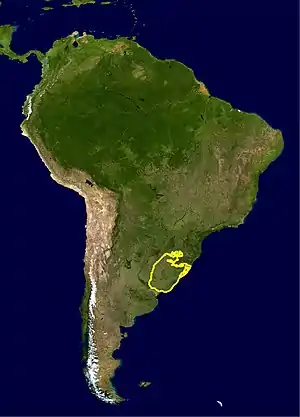Uruguayan savanna
The Uruguayan savanna, also known as the Brazilian-Uruguayan savanna, is a subtropical grassland and savanna ecoregion which includes all of Uruguay, some areas of northeastern Argentina and southernmost Brazil.
| Uruguayan savanna | |
|---|---|
 | |
 Ecoregion territory (yellow boundaries) | |
| Ecology | |
| Realm | Neotropical |
| Biome | tropical and subtropical grasslands, savannas, and shrublands |
| Borders | |
| Geography | |
| Area | 351,329 km2 (135,649 sq mi) |
| Countries | Uruguay, Brazil, and Argentina |
| Conservation | |
| Conservation status | Critical/endangered |
| Protected | 19,245 km² (5%)[1] |
Flora
The ecoregion consists mostly of medium-tall grasslands, with areas of palm savanna, gallery forests along rivers, and enclaves of submontane forest.
Fauna
Grazing mammals include the Pampas Deer (Ozotoceros bezoarticus), the Gray Brocket or Guazuvirá Deer (Mazama gouazoubira), and the capybara (Hydrochoerus hydrochaeris), the world's largest living rodent.
External links
| Wikimedia Commons has media related to Uruguayan savanna. |
- "Uruguayan savanna". Terrestrial Ecoregions. World Wildlife Fund. Retrieved 10 October 2013.
References
This article is issued from Wikipedia. The text is licensed under Creative Commons - Attribution - Sharealike. Additional terms may apply for the media files.
